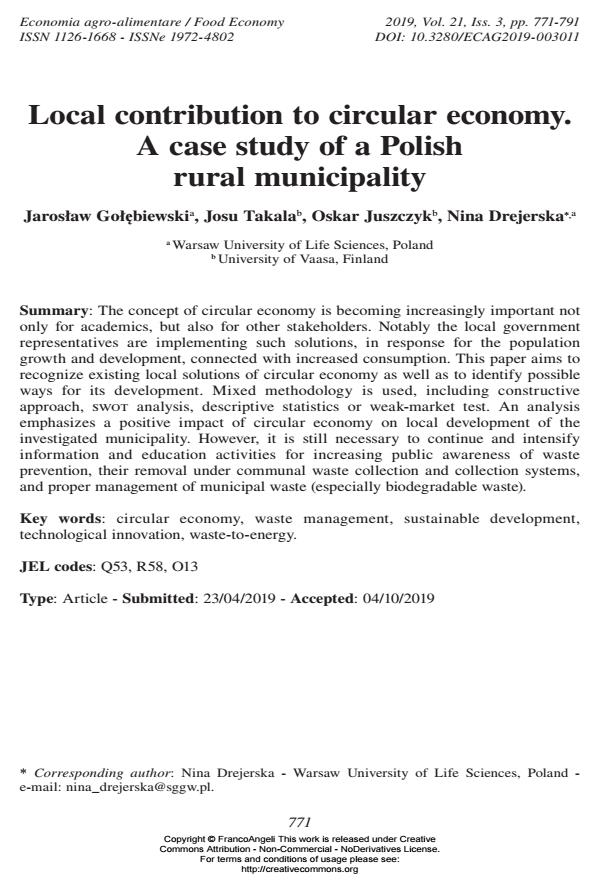Local contribution to circular economy. A case study of a Polish rural municipality
Journal title ECONOMIA AGRO-ALIMENTARE
Author/s Jaroslaw Golebiewski, Josu Takala, Oskar Juszczyk, Nina Drejerska
Publishing Year 2020 Issue 2019/3
Language English Pages 21 P. 771-791 File size 251 KB
DOI 10.3280/ECAG2019-003011
DOI is like a bar code for intellectual property: to have more infomation
click here

FrancoAngeli is member of Publishers International Linking Association, Inc (PILA), a not-for-profit association which run the CrossRef service enabling links to and from online scholarly content.
The concept of circular economy is becoming increasingly important not only for academics, but also for other stakeholders. Notably the local government representatives are implementing such solutions, in response for the population growth and development, connected with increased consumption. This paper aims to recognize existing local solutions of circular economy as well as to identify possible ways for its development. Mixed methodology is used, including constructive approach, swot analysis, descriptive statistics or weak-market test. An analysis emphasizes a positive impact of circular economy on local development of the investigated municipality. However, it is still necessary to continue and intensify information and education activities for increasing public awareness of waste prevention, their removal under communal waste collection and collection systems, and proper management of municipal waste (especially biodegradable waste).
Keywords: Circular economy, waste management, sustainable development, technological innovation, waste-to-energy.
Jel codes: Q53, R58, O13
- The Circular Economy in the Agri-food system: A Performance Measurement of European Countries Brunella Arru, Roberto Furesi, Pietro Pulina, Paola Sau, Fabio A. Madau, in Economia agro-alimentare 2/2022 pp.1
DOI: 10.3280/ecag2022oa13245 - The circular potential of a Bio-District: indicators for waste management Stefano Poponi, Alessandro Ruggieri, Francesco Pacchera, Gabriella Arcese, in British Food Journal /2024 pp.290
DOI: 10.1108/BFJ-12-2022-1137 - Community composting: A multidisciplinary evaluation of an inclusive, participative, and eco-friendly approach to biowaste management Annalisa De Boni, Francesca Maria Melucci, Claudio Acciani, Rocco Roma, in Cleaner Environmental Systems 100092/2022 pp.100092
DOI: 10.1016/j.cesys.2022.100092
Jaroslaw Golebiewski, Josu Takala, Oskar Juszczyk, Nina Drejerska, Local contribution to circular economy. A case study of a Polish rural municipality in "ECONOMIA AGRO-ALIMENTARE" 3/2019, pp 771-791, DOI: 10.3280/ECAG2019-003011